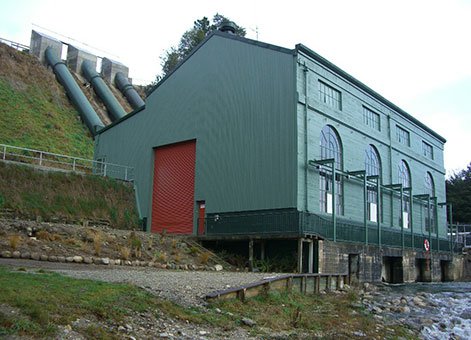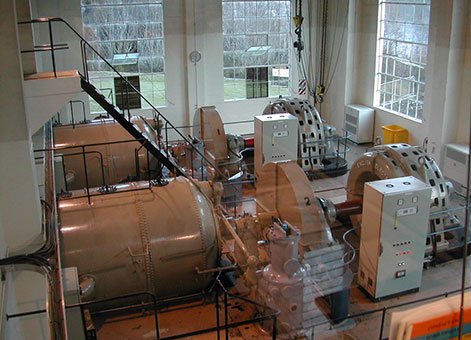The potential for the Monowai hydro-electric scheme was first identified in 1914 when the Southland League investigated local natural resources. Starting in 1894 a number of private and local council coal powered power stations had met demand, but by the time the Southland Electric Power Board was formed in 1918, and with increasing local reticulation, a more substantial supply was needed. Accordingly, work was started on constructing Monowai in 1921, and the station opened in May 1925.

Monowai Power Station, circa 2004. IPENZ.
The river flows out through two bays of the original four bay outlet structure. The flow rate is remotely controlled by two radial steel gates. Water is first directed into a ponding area and then, via an 865-metre-long canal, to a forebay. A single 1,000 metre pipeline then takes the water to an intermediate surge chamber before three steel penstocks carry it down to the powerhouse.
The plant initially consisted of two British built, double runner Francis type turbines using belt driven oil-pressure type governors. These turbines were based on a Swedish design still used today in some Swedish power stations. Each unit drove a 2 megawatt (MW) English Electric generator. Separate hydro driven exciters were used. In 1927 a third unit was installed with the same turbine, but using a British Thompson-Houston generator. The plant produced 35–40 gigawatt hours of electricity per year.

Monowai Power Station plant prior to upgrade, circa 2004. IPENZ.
An unusual feature was that the powerhouse foundation was built as a tank so that the Waiau River into which the station discharges could rise over one metre above floor level before generation would have to stop.
Over the years there were a number of major overhauls, including replacement of governing and excitation equipment, replacement of the original lignum vitae turbine bearings, and of the turbine runners.
Various plant upgrades were considered over the years. This was to reduce the increasing maintenance needed on very old equipment, and to better accommodate the characteristics of the river flow. However, as it was for the first installation, the access road and bridge weight and size limitations constrained choices of plant. Footage of the power station circa 1990 is available on YouTube.

Monowai Power Station's upgraded plant, circa 2004. IPENZ.
In 2004 it was decided to replace the units, and three 2.6MW vertical shaft turbine-generators using Francis turbines were installed one in each year 2005, 2006 and 2007 by Invercargill firm Alltec Engineering Limited. These units have Swedish TURAB turbines and Spanish Alconza generators. Also the old riveted penstocks were replaced by 1.6m diameter welded steel penstocks.
Nevertheless, the whole scheme remains as a working testament to the foresight of the local people and the skill or the engineers who conceived and built it.
Of the replaced units, the second generator and the third turbine and generator were acquired by Clearwater Hydro of Tauranga, and one unit has since been put into service at a small hydro-electric station near Waitomo in the Waikato. A further proof of both good design and manufacture and of operation and maintenance of these old generating units.
Find out more
Access
This is a working power station and is only accessible by the public by appointment.
Location
Monowai is located approximately 50 kilomteres from Tuatapere, Southland. The town and power station are positioned along Turbine Drive, which can be reached from Blackmount-Redcliff Road via Lake Monowai Road.



